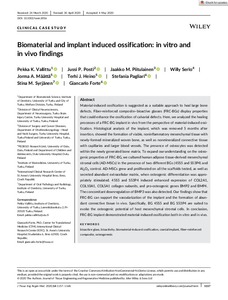Biomaterial and implant induced ossification: in vitro and in vivo findings
Serlo W; Heino TJ; Forte G; Piitulainen JM; Syrjänen SM; Vallittu PK; Määttä JA; Pagliari S; Posti JP
Biomaterial and implant induced ossification: in vitro and in vivo findings
Serlo W
Heino TJ
Forte G
Piitulainen JM
Syrjänen SM
Vallittu PK
Määttä JA
Pagliari S
Posti JP
Julkaisun pysyvä osoite on:
https://urn.fi/URN:NBN:fi-fe2021042825853
https://urn.fi/URN:NBN:fi-fe2021042825853
Tiivistelmä
Material-induced ossification is suggested as a suitable approach to heal large bone defects. Fiber-reinforced composite-bioactive glasses (FRC-BG) display properties which could enhance the ossification of calvarial defects. Here, we analyzed the healing processes of a FRC-BG implant in vivo from the perspective of material-induced ossification. Histological analysis of the implant, which was removed five months after insertion, showed the formation of viable, non-inflammatory mesenchymal tissue with newly-formed mineralized woven bone, as well as non-mineralized connective tissue with capillaries and larger blood vessels. The presence of osteocytes was detected within the newly generated bone matrix. To expand our understanding on the osteogenic properties of FRC-BG, we cultured human adipose tissue-derived mesenchymal stromal cells (AD-MSCs) in the presence of two different BGs (45S5 and S53P4) and Al2 O3 control. AD-MSCs grew and proliferated on all the scaffolds tested, as well as secreted abundant extracellular matrix, when osteogenic differentiation was appropriately stimulated. 45S5 and S53P4 induced enhanced expression of COL2A1, COL10A1, COL5A1 collagen subunits and pro-osteogenic genes BMP2 and BMP4. The concomitant downregulation of BMP3 was also detected. Our findings show that FRC-BG can support the vascularization of the implant and the formation of abundant connective tissue in vivo. Specifically, BG 45S5 and BG S53P4 are suited to evoke the osteogenic potential of host mesenchymal stromal cells. In conclusion, FRC-BG implant demonstrated material-induced ossification both in vitro and in vivo.
Kokoelmat
- Rinnakkaistallenteet [19218]
